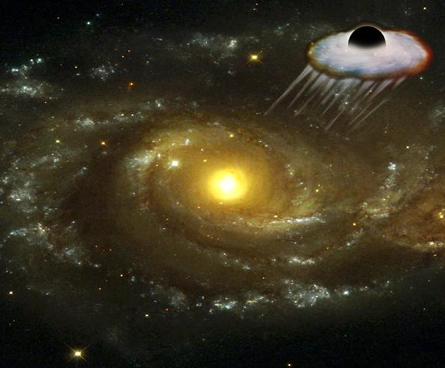Kicked out of its home galaxy by a gravitational rocket, a supermassive black hole roams intergalactic space, a solitary glutton seeking a fresh supply of gas and stars for its next meal.
That may sound like science fiction, but researchers say they now have the first observational hint that black holes weighing millions to billions of times as much as the sun really can be ejected from the galaxies in which they formed.
If confirmed, the finding would have far-reaching implications for understanding galaxy formation. Mounting evidence suggests not only that every large galaxy houses a supermassive black hole at its core, but that a galaxy’s central hub of stars grows in lockstep with the mass of the black hole. Now it appears that some galaxies may be deprived of the monsters that somehow regulated their growth.
A kick would also provide a profound confirmation of recent supercomputer simulations of Einstein’s theory of general relativity. The kick is believed to be generated when two giant black holes from different galaxies merge, unleashing an enormous burst of gravitational radiation. These proposed ripples in space-time, predicted by Einstein’s theory, travel at the speed of light. Most of the gravitational radiation is emitted in one direction, pushing the merged black hole system in the opposite direction, like the kickback from a shotgun. If the kick is big enough, according to simulations, the merged supermassive black hole could exit its galaxy.
In their study, Stefanie Komossa and her colleagues at the Max Planck Institute for Extraterrestrial Physics in Garching, Germany, examined the spectrum of light from a quasar, a brilliant beacon with the unwieldy name SDSS J092712.65+294344.0. Quasars, which lie at the center of galaxies, are fueled by black holes.
An analysis of the quasar spectrum reveals a pattern of light emission that matches that expected from a supermassive black hole shot out of the galaxy’s center, the team reports in the May 10 Astrophysical Journal Letters.
The researchers focused on the character of emission in the quasar’s spectrum. Gas that is tightly bound to an ejected black hole would stay with the expelled hole and produce a broad emission line — broad because the gas is rotating rapidly around the hole, thereby producing, to a distant observer, a fat rather than a narrow peak. Gas loosely bound to the hole just before the kick would stay behind. Since that gas rotates more slowly, it would produce a narrower emission line. That’s just what Komossa’s team has detected.
The team calculates that the booted black hole is recoiling at 2,650 kilometers a second, tantamount to traveling from New York to Los Angeles in under two seconds. Although the black hole, as massive as several hundred million suns, still lies within the galaxy, “its speed is so high that nothing will prevent it from ultimately leaving its host galaxy completely,” Komossa says.
This scenario faces one potential problem, however. The researchers also find a puzzling third emission line, which leaves a major question mark in their work, notes Cole Miller of the University of Maryland in College Park. The third line is also narrow but bluer in color than the other narrow line. Miller worries that the two colors indicate that Komossa’s team is actually observing the superposition of two separate quasars that have similar but not identical distances. If so, the interpretation of a recoiling black hole would not be correct, Miller notes.
“This is an exciting result, but I think it is very possible that this is a chance superposition of two quasars along the same line of sight, rather than a fast kick,” Miller says.
Komossa says her team carefully considered but rejected the idea of a chance superposition as “excessively unlikely.” Komossa and Miller agree that images of the region taken by the Hubble Space Telescope would settle the controversy. If Hubble finds a second galaxy at a distance coinciding with the broad emission line, a superposition is likely. If not, “the kick possibility is stronger,” says Miller.
“We now believe that galaxies and supermassive black holes form and evolve together,” says Komossa. “If a substantial number of black holes are propelled from their host galaxies, we have a population of galaxies without black holes in their cores, and an important question then is, how these would evolve.”








